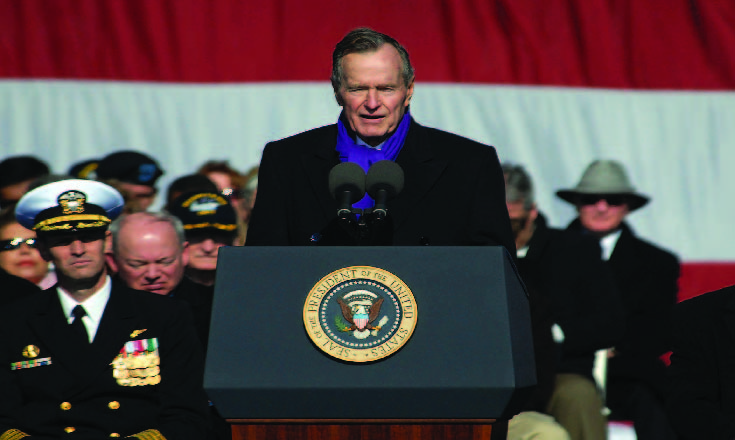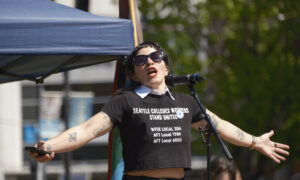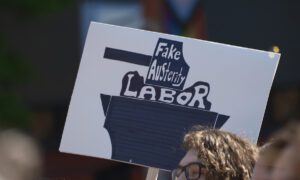 George H.W. Bush passed away on November 30th. He was most notable as being the 41st President of the United States of America, but his political prowess extends far beyond that achievement.
George H.W. Bush passed away on November 30th. He was most notable as being the 41st President of the United States of America, but his political prowess extends far beyond that achievement.
From his humble Massachusetts beginnings, former President Bush went on to pick himself up by the boot-straps and through loans from wealthy friends and family built himself into a millionaire Texas oil tycoon. He amassed this great wealth while being the president of Zapata Petroleum, an off-shore oil company he created in 1953 with Thomas J. Devine, who left his position as a CIA staffer to join his friend and colleague in the private sector. In 1954 Zapata Petroleum became Zapata Off-shore and with its financial backing of the creation of “mobile but secure” off-shore drilling technologies was able to drop an astounding number of off-shore oil rigs in the Gulf of Mexico, the Persian Gulf, Trinidad, Borneo, Medellín and Colombia.
After this amassing of wealth, the young Bush decided to try his hand at politics. In 1963 he was elected chairman of the Harris County, Texas Republican Party, campaigning as a young new conservative who would wipe away the cobwebs of stuffy old liberal democrats in the region. It was a breath of fresh air to the people of Texas that a man not afraid of controversy was now leading their local party. Through campaigns against Civil Rights legislation that was making its way through Congress, he won the hearts and minds of the New Republican Party and became an influential figure within it. Not one to leave his friends and compatriots behind, his first few orders of business were to re-absorb members of the John Birch Society (perhaps the oldest far-right racist organization in the country still active today) and disaffected members of the Democratic party staunchly committed to segregation back into the Republican Party itself. We owe much of what the modern day Republican Party looks like to this great and wealthy Texan.
As his political career rose, George H.W. Bush filled many roles. Former President Nixon appointed him United States Ambassador to the United Nations, a position in which he served for 2 years starting in 1971. With the backdrop of Watergate, Nixon requested that Former President Bush become the chairman of the Republican National Committee in 1973. It was in this position that Former President Bush requested Nixon resign–for the good of the party.
In 1976 Former President Bush received his first real break into the world of policy and prestige when President Gerald Ford appointed him Director of the Central Intelligence Agency (CIA). He was able to effect great change and achieved much in his short 357 days as Director. Most notably was the CIA’s massive support for Operation Condor, a plan to destabilize South America through terror campaigns and the backing of right wing dictators in the hopes of reducing both Communist and Soviet influence in the region. Ever humble, the CIA itself did not openly take direct responsibility for operation Condor, so some of it’s feats are still unknown to us. But it is estimated that around 60,000 deaths of dissidents, leftists, clergy, students, union leaders, suspected guerrillas and teachers can be attributed to the operation. Which is no small claim.
It w as then that Former President Bush would go on to serve in the White House as Ronald Reagan’s Vice President for two terms, from 1981 to 1989. While the many exploits of the Reagan administration are known far and wide, it is best for us to remember some of the more stellar activities of this Washington powerhouse duo. Most notable were the Iran-Contra Scandal of 1986, the fortifying of the War on Drugs and implementation of mandatory minimums for drug sentencing, the Immigration Reform and Control Act of 1986 that hardened penalties for hiring “illegal immigrants” and fortified the US-Mexico Border, a rejection of sexual health education in favor of abstinence-only sex education amidst the height of the AIDS crisis , and Executive Order 12333, which greatly increased the mass surveillance of anyone deemed a threat on US soil.
as then that Former President Bush would go on to serve in the White House as Ronald Reagan’s Vice President for two terms, from 1981 to 1989. While the many exploits of the Reagan administration are known far and wide, it is best for us to remember some of the more stellar activities of this Washington powerhouse duo. Most notable were the Iran-Contra Scandal of 1986, the fortifying of the War on Drugs and implementation of mandatory minimums for drug sentencing, the Immigration Reform and Control Act of 1986 that hardened penalties for hiring “illegal immigrants” and fortified the US-Mexico Border, a rejection of sexual health education in favor of abstinence-only sex education amidst the height of the AIDS crisis , and Executive Order 12333, which greatly increased the mass surveillance of anyone deemed a threat on US soil.
We would all be remiss if we did not mention Former President Reagan’s failures along with his deep victories. He was unable to pass his federal ban on abortions and an end to desegregation busing. He was unable to block affirmative action from becoming a norm and reluctantly allowed Martin Luther King Jr. Day to become a federal holiday. Even Congress was not on his side in 1988 when they overrode his veto on the Civil Rights Restoration Act. Presidential life is a hard and arduous one, and it does not always end in victory.
In 1988 Former President Bush made his first Presidential bid. He wowed his own party with a now famous speech about his campaign where he stuck to his guns by backing capital punishment, prayer in schools, gun rights, and his Christian opposition to abortion. It was then and there that Bush laid out his ideal America and cemented himself as one of the backers of 20th century conservatism. Bush won this campaign and became President of the United States in 1989.
During his terms as President, Bush oversaw a series of diverse initiatives and policy shifts. Some were more popular than others, but this ought to be the case when dealing with important matters of State. He oversaw military operations in Panama and Somalia, the end of the Cold War, the beginning of the First Gulf War and its accompanying sanctions, and the beginning of the North American Free Trade Agreement (NAFTA), which can be linked directly to the creation of an international protest sensation called “the anti-globalization movement” where the Left from the United States linked with indigenous peoples from around the world to fight unfair labor practices and environmental degradation created under the trade agreement. An entirely indigenous army was created in Mexico called the EZLN just to combat this trade agreement. Clearly, Bush’s legacy will continue to live on. And as Presidents are wont to do, there were several pardon’s at the end of his first term, mostly those who were implicated inside of the Iran-Contra scandal and had been imprisoned when Bush was still a sitting Vice-President.
Bush and his wife, Barbara, retired in 1993 after his final run for president had concluded. But his relationship to shaping national policy was not over and he was far from out of the spotlight. In 1993 he survived an assassination attempt but wa s vindicated when, months later, President Clinton sent 23 cruise missiles at the Iraqi Intelligence Service headquarters in Baghdad. In the same year he was also given an honorary knighthood by Queen Elizabeth II. In 1996, he threw his full support behind Presidential nominee Bob Dole and used his experience in debating Clinton to give advice. And in 1999, he called for the release of former Chilean Dictator Pinochet, who had assumed power in Chile following a United States-backed coup on September 11th, 1973, which is often modernly referred to as “the other September 11th”. Pinochet was being held in Spain under human rights violations in the murder and disappearance of thousands of people under his rule.
s vindicated when, months later, President Clinton sent 23 cruise missiles at the Iraqi Intelligence Service headquarters in Baghdad. In the same year he was also given an honorary knighthood by Queen Elizabeth II. In 1996, he threw his full support behind Presidential nominee Bob Dole and used his experience in debating Clinton to give advice. And in 1999, he called for the release of former Chilean Dictator Pinochet, who had assumed power in Chile following a United States-backed coup on September 11th, 1973, which is often modernly referred to as “the other September 11th”. Pinochet was being held in Spain under human rights violations in the murder and disappearance of thousands of people under his rule.
Former President Bush was even making headlines past his 90th birthday, when he became a part of the #MeToo movement. Allegations against Bush surfaced in October 2017 from actress Heather Lind. Afterwards, similar allegations were brought forth by several other women, some of whom were under 18 at the time of the alleged misconduct. Through a spokesman, Bush apologized for these incidents, but it is unclear if a resolution to those charges was ever found. It will have to remain a part of his legacy as we all move forward.
Former President Bush was diagnosed with a form of Parkinson’s disease in 2012, and used a motorized wheelchair for his remaining years. He died on November 30th in his home in Houston, Texas at the age of 94.






